ABS RENAULT TWINGO 2009 2.G Heating And Air Conditioning - Manual Air Conditioning Workshop Manual
[x] Cancel search | Manufacturer: RENAULT, Model Year: 2009, Model line: TWINGO, Model: RENAULT TWINGO 2009 2.GPages: 63
Page 5 of 63
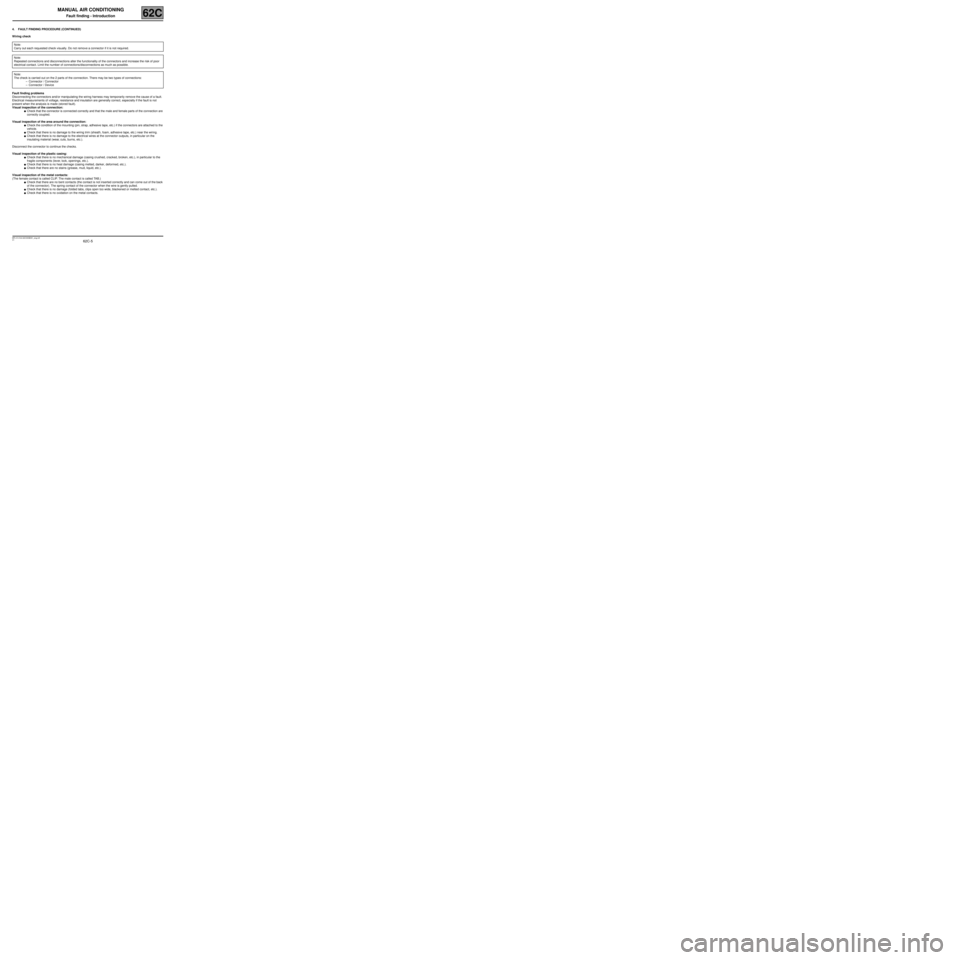
62C-5
MR-413-X44-62C000$091_eng.mif
V1
MANUAL AIR CONDITIONING
Fault finding - Introduction62C
4. FAULT FINDING PROCEDURE (CONTINUED)
Wiring check
Fault finding problems
Disconnecting the connectors and/or manipulating the wiring harness may temporarily remove the cause of a fault.
Electrical measurements of voltage, resistance and insulation are generally correct, especially if the fault is not
present when the analysis is made (stored fault).
Visual inspection of the connection:
●Check that the connector is connected correctly and that the male and female parts of the connection are
correctly coupled.
Visual inspection of the area around the connection:
●Check the condition of the mounting (pin, strap, adhesive tape, etc.) if the connectors are attached to the
vehicle.
●Check that there is no damage to the wiring trim (sheath, foam, adhesive tape, etc.) near the wiring.
●Check that there is no damage to the electrical wires at the connector outputs, in particular on the
insulating material (wear, cuts, burns, etc.).
Disconnect the connector to continue the checks.
Visual inspection of the plastic casing:
●Check that there is no mechanical damage (casing crushed, cracked, broken, etc.), in particular to the
fragile components (lever, lock, openings, etc.).
●Check that there is no heat damage (casing melted, darker, deformed, etc.).
●Check that there are no stains (grease, mud, liquid, etc.).
Visual inspection of the metal contacts:
(The female contact is called CLIP. The male contact is called TAB.)
●Check that there are no bent contacts (the contact is not inserted correctly and can come out of the back
of the connector). The spring contact of the connector when the wire is gently pulled.
●Check that there is no damage (folded tabs, clips open too wide, blackened or melted contact, etc.).
●Check that there is no oxidation on the metal contacts. Note:
Carry out each requested check visually. Do not remove a connector if it is not required.
Note:
Repeated connections and disconnections alter the functionality of the connectors and increase the risk of poor
electrical contact. Limit the number of connections/disconnections as much as possible.
Note:
The check is carried out on the 2 parts of the connection. There may be two types of connections:
–Connector / Connector
–Connector / Device
Page 10 of 63
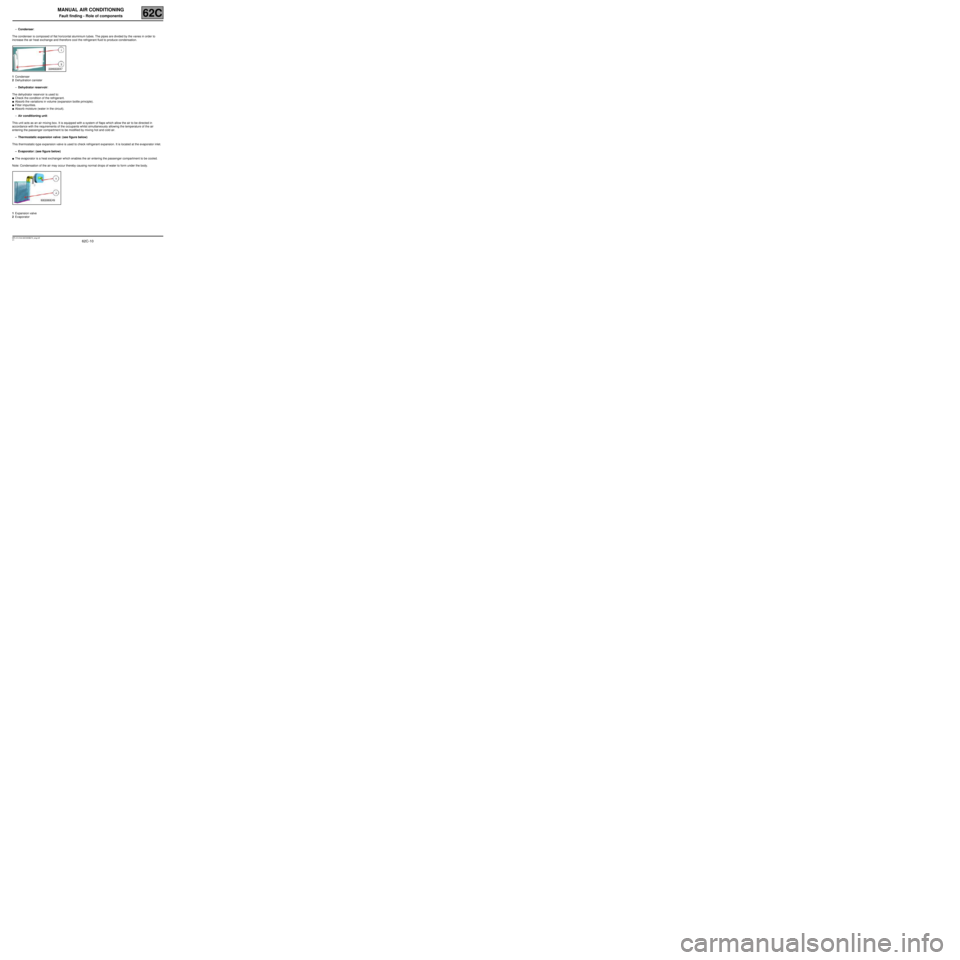
62C-10
MR-413-X44-62C000$273_eng.mif
V1
MANUAL AIR CONDITIONING
Fault finding - Role of components62C
–Condenser:
The condenser is composed of flat horizontal aluminium tubes. The pipes are divided by the vanes in order to
increase the air heat exchange and therefore cool the refrigerant fluid to produce condensation.
1Condenser
2Dehydration canister
–Dehydrator reservoir:
The dehydrator reservoir is used to:
●Check the condition of the refrigerant.
●Absorb the variations in volume (expansion bottle principle).
●Filter impurities.
●Absorb moisture (water in the circuit).
–Air conditioning unit:
This unit acts as an air mixing box. It is equipped with a system of flaps which allow the air to be directed in
accordance with the requirements of the occupants whilst simultaneously allowing the temperature of the air
entering the passenger compartment to be modified by mixing hot and cold air.
–Thermostatic expansion valve: (see figure below)
This thermostatic-type expansion valve is used to check refrigerant expansion. It is located at the evaporator inlet.
–Evaporator: (see figure below)
●The evaporator is a heat exchanger which enables the air entering the passenger compartment to be cooled.
Note: Condensation of the air may occur thereby causing normal drops of water to form under the body.
1
1Expansion valve
2Evaporator
Page 11 of 63
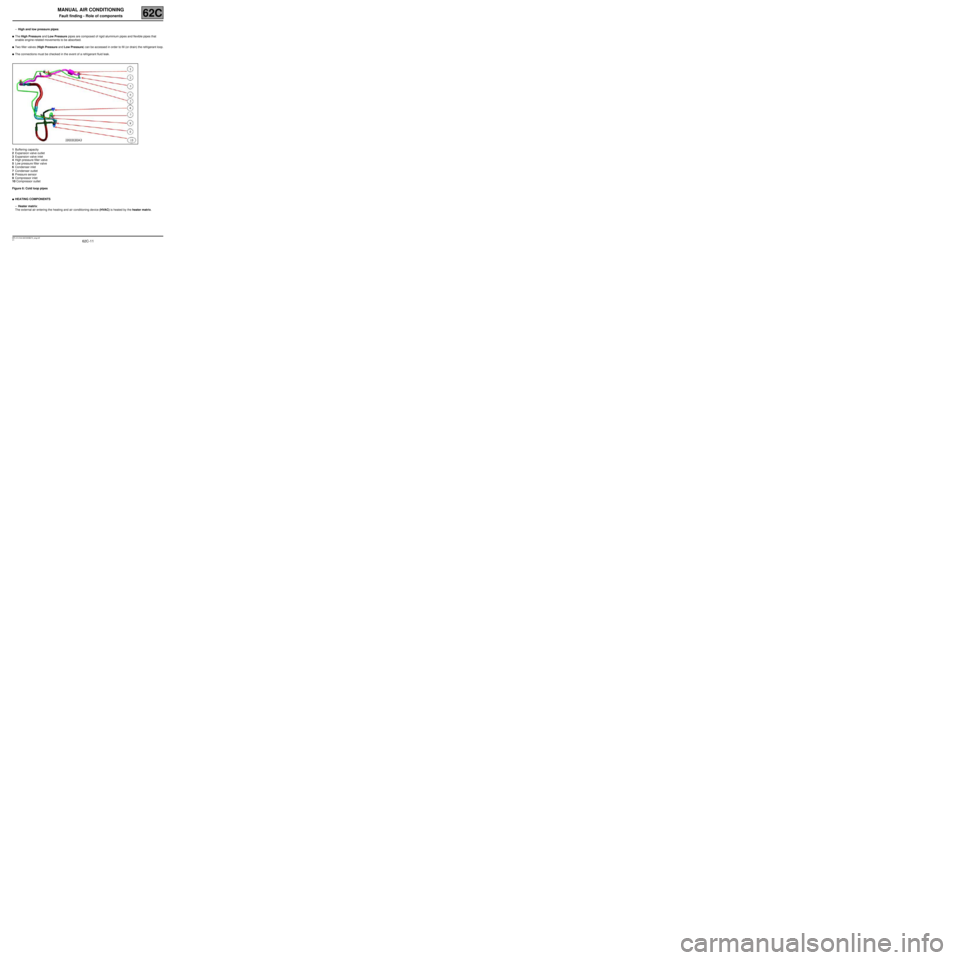
62C-11
MR-413-X44-62C000$273_eng.mif
V1
MANUAL AIR CONDITIONING
Fault finding - Role of components62C
–High and low pressure pipes:
●The High Pressure and Low Pressure pipes are composed of rigid aluminium pipes and flexible pipes that
enable engine-related movements to be absorbed.
●Two filler valves (High Pressure and Low Pressure) can be accessed in order to fill (or drain) the refrigerant loop.
●The connections must be checked in the event of a refrigerant fluid leak.
1Buffering capacity
2Expansion valve outlet
3Expansion valve inlet
4High pressure filler valve
5Low pressure filler valve
6Condenser inlet
7Condenser outlet
8Pressure sensor
9Compressor inlet
10 Compressor outlet
Figure 6: Cold loop pipes
●HEATING COMPONENTS
–Heater matrix:
The external air entering the heating and air conditioning device (HVAC) is heated by the heater matrix.
Page 23 of 63
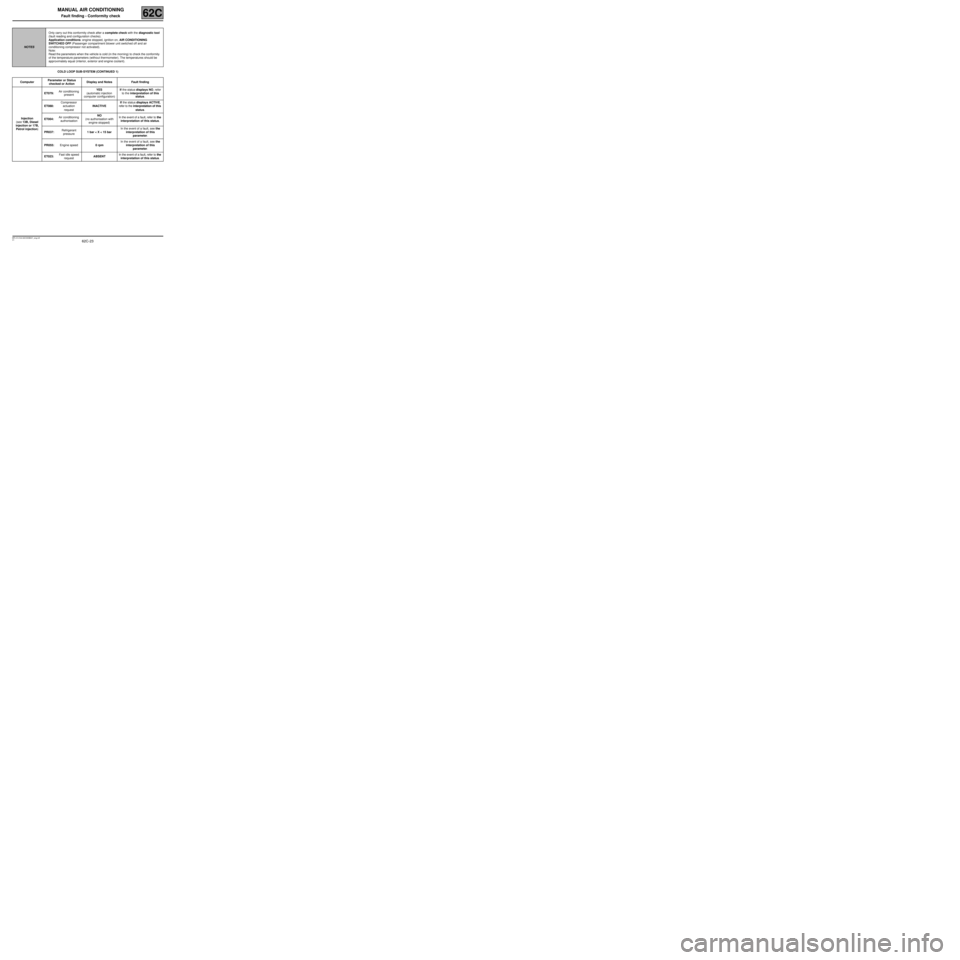
62C-23
MR-413-X44-62C000$637_eng.mif
V1
MANUAL AIR CONDITIONING
Fault finding - Conformity check62C
COLD LOOP SUB-SYSTEM (CONTINUED 1)
NOTESOnly carry out this conformity check after a complete check with the diagnostic tool
(fault reading and configuration checks).
Application conditions: engine stopped, ignition on, AIR CONDITIONING
SWITCHED OFF (Passenger compartment blower unit switched off and air
conditioning compressor not activated).
Note:
Read the parameters when the vehicle is cold (in the morning) to check the conformity
of the temperature parameters (without thermometer). The temperatures should be
approximately equal (interior, exterior and engine coolant).
ComputerParameter or Status
checked or ActionDisplay and Notes Fault finding
Injection
(see 13B, Diesel
injection or 17B,
Petrol injection)ET079:Air conditioning
presentYES
(automatic injection
computer configuration)If the status displays NO, refer
to the interpretation of this
status.
ET088:Compressor
actuation
requestINACTIVEIf the status displays ACTIVE,
refer to the interpretation of this
status.
ET004:Air conditioning
authorisationNO
(no authorisation with
engine stopped)In the event of a fault, refer to the
interpretation of this status.
PR037:Refrigerant
pressure 1 bar < X < 15 barIn the event of a fault, see the
interpretation of this
parameter.
PR055:Engine speed0 rpmIn the event of a fault, see the
interpretation of this
parameter.
ET023:Fast idle speed
requestABSENTIn the event of a fault, refer to the
interpretation of this status.
Page 24 of 63
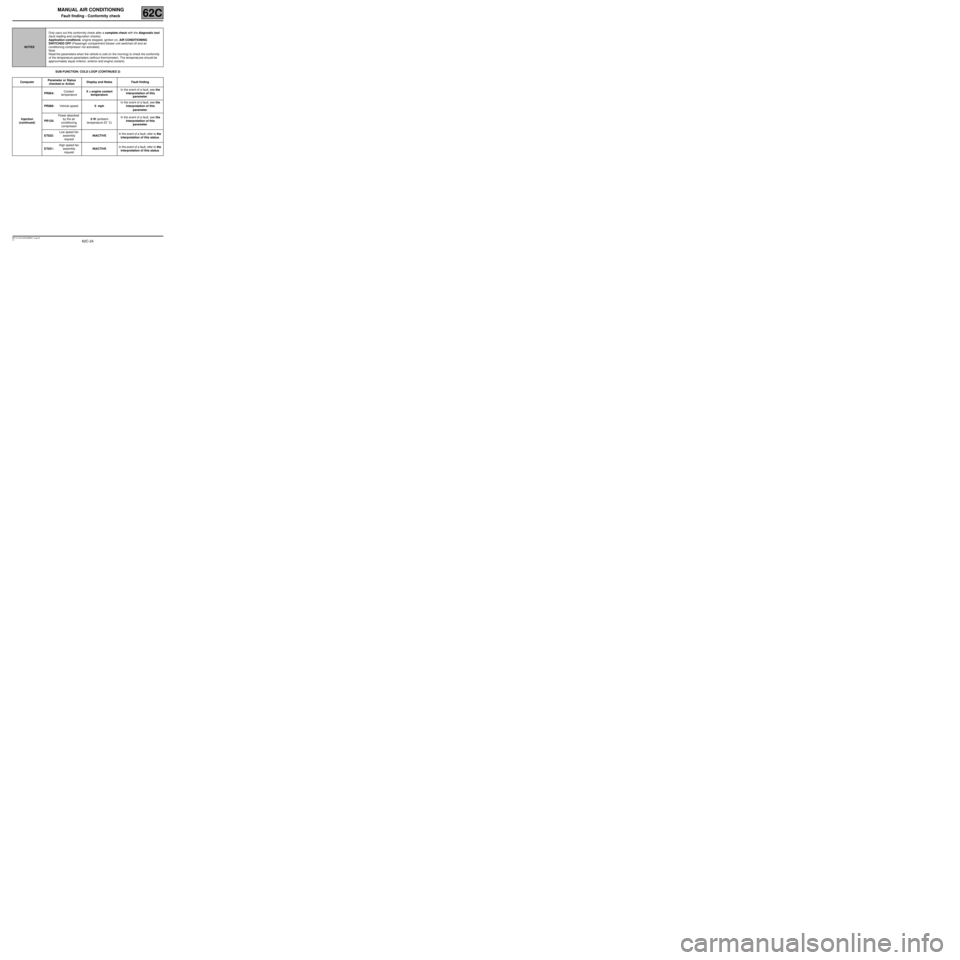
62C-24
MR-413-X44-62C000$637_eng.mif
V1
MANUAL AIR CONDITIONING
Fault finding - Conformity check62C
SUB-FUNCTION: COLD LOOP (CONTINUED 2)
NOTESOnly carry out this conformity check after a complete check with the diagnostic tool
(fault reading and configuration checks).
Application conditions: engine stopped, ignition on, AIR CONDITIONING
SWITCHED OFF (Passenger compartment blower unit switched off and air
conditioning compressor not activated).
Note:
Read the parameters when the vehicle is cold (in the morning) to check the conformity
of the temperature parameters (without thermometer). The temperatures should be
approximately equal (interior, exterior and engine coolant).
ComputerParameter or Status
checked or ActionDisplay and Notes Fault finding
Injection
(continued)PR064:Coolant
temperatureX = engine coolant
temperatureIn the event of a fault, see the
interpretation of this
parameter.
PR089:Vehicle speed0 mphIn the event of a fault, see the
interpretation of this
parameter.
PR125:Power absorbed
by the air
conditioning
compressor0 W (ambient
temperature 23 ˚C)In the event of a fault, see the
interpretation of this
parameter.
ET022:Low speed fan
assembly
requestINACTIVEIn the event of a fault, refer to the
interpretation of this status.
ET021:High speed fan
assembly
requestINACTIVEIn the event of a fault, refer to the
interpretation of this status.
Page 30 of 63
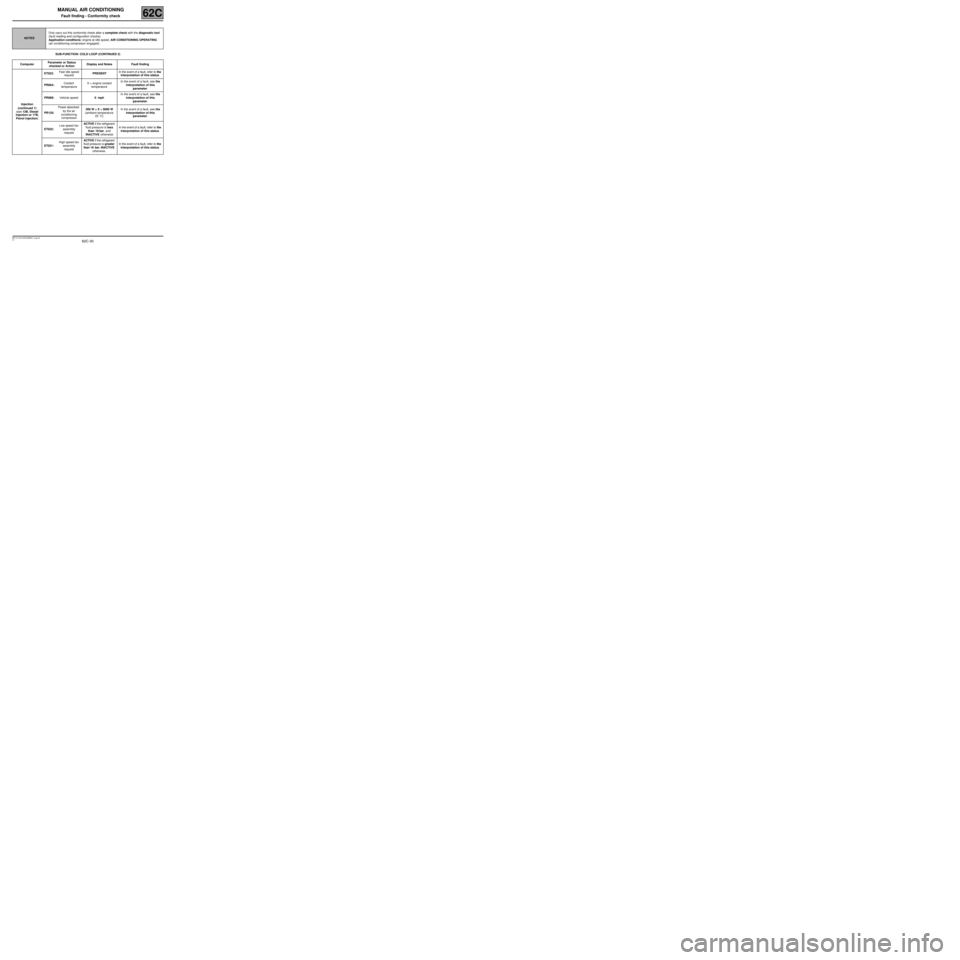
62C-30
MR-413-X44-62C000$637_eng.mif
V1
MANUAL AIR CONDITIONING
Fault finding - Conformity check62C
SUB-FUNCTION: COLD LOOP (CONTINUED 2)
NOTESOnly carry out this conformity check after a complete check with the diagnostic tool
(fault reading and configuration checks).
Application conditions: engine at idle speed, AIR CONDITIONING OPERATING
(air conditioning compressor engaged).
ComputerParameter or Status
checked or ActionDisplay and Notes Fault finding
Injection
(continued 1)
(see 13B, Diesel
injection or 17B,
Petrol injection)ET023:Fast idle speed
requestPRESENTIn the event of a fault, refer to the
interpretation of this status.
PR064:Coolant
temperatureX = engine coolant
temperatureIn the event of a fault, see the
interpretation of this
parameter.
PR089:Vehicle speed0 mphIn the event of a fault, see the
interpretation of this
parameter.
PR125:Power absorbed
by the air
conditioning
compressor300 W < X < 5000 W
(ambient temperature
23 ˚C)In the event of a fault, see the
interpretation of this
parameter.
ET022:Low speed fan
assembly
requestACTIVE if the refrigerant
fluid pressure is less
than 19 bar, and
INACTIVE otherwiseIn the event of a fault, refer to the
interpretation of this status.
ET021:High speed fan
assembly
requestACTIVE if the refrigerant
fluid pressure is greater
than 19 bar, INACTIVE
otherwise.In the event of a fault, refer to the
interpretation of this status.